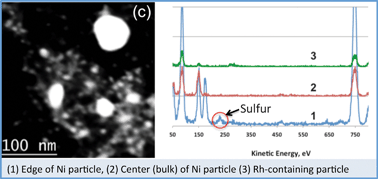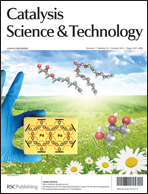Sulfur poisoning of Rh–Ni catalysts during steam reforming of sulfur-containing liquid fuels
Abstract
Sulfur poisoning during steam reforming is considered a significant barrier to synthesizing an active and stable catalyst. The present study investigates the mechanism of sulfur poisoning on a rhodium promoted nickel catalyst surface and uses the results to demonstrate how rhodium addition improves sulfur tolerance. Catalysts containing Ni and/or Rh supported on γ-alumina were synthesized and evaluated in a fixed-bed tubular reactor at a steam to carbon ratio of 3, 1000 ppm of sulfur, a temperature of 800 °C and atmospheric pressure. Hydrogen yield was used to evaluate catalyst activity while H2S in the effluent was monitored to determine the amount of sulfur trapped on the catalyst surface. In order to understand the mechanism of sulfur poisoning, fresh and used catalysts were characterized using pulse chemisorption, BET surface area analysis, transmission electron microscopy (TEM) and energy dispersive spectroscopy (EDS). Visual probing of the catalyst microstructure using TEM coupled with EDS revealed preferential adsorption of sulfur on nickel particles as multiple surface adlayers. There was no bulk nickel sulfide formation. Using pulse chemisorption studies and sulfur yields, it was shown that addition of rhodium to the nickel catalyst helps in lowering the amount of sulfur adlayers on the catalyst surface, thereby leading to improved sulfur tolerance, and this phenomenon was attributed to the close interaction of rhodium with nickel including the possibility of Rh–Ni alloy formation.


 Please wait while we load your content...
Please wait while we load your content...